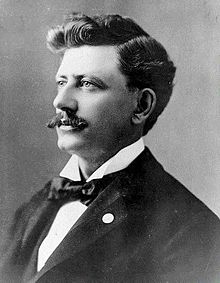John E. Osborne
| John Eugene Osborne | |
|---|---|
 |
|
| 3rd Governor of Wyoming | |
|
In office January 2, 1893 – January 7, 1895 |
|
| Preceded by | Amos W. Barber |
| Succeeded by | William A. Richards |
| 29th United States Assistant Secretary of State | |
|
In office April 21, 1913 – December 14, 1916 |
|
| Preceded by | Huntington Wilson |
| Succeeded by | William Phillips |
| Member of the U.S. House of Representatives from Wyoming's At-large district |
|
|
In office March 4, 1897 – March 3, 1899 |
|
| Preceded by | Frank W. Mondell |
| Succeeded by | Frank W. Mondell |
| Personal details | |
| Born |
June 19, 1858 Westport, New York, U.S. |
| Died | April 24, 1943 (aged 84) Rawlins, Wyoming, U.S. |
| Political party | Democratic |
| Spouse(s) | Selina Smith |
| Education | University of Vermont (1880) |
| Profession | Physician, politician, banker, farmer |
John Eugene Osborne (June 19, 1858 – April 24, 1943) was an American physician, farmer, banker and Democratic politician. He was the third Governor of Wyoming after the Wyoming Territory attained statehood in 1890.
Osborne was born in Westport, New York, the younger son of John C. Osborne and Mary E. Rail. His parents were both immigrants, his father from England and his mother from Canada. Osborne studied medicine at the University of Vermont and graduated in 1880. He was then hired as a surgeon by the Union Pacific Railroad, and moved to Rawlins, Carbon County, Wyoming.
In 1883, Osborne was elected to Wyoming's House of the Territorial Assembly, but resigned in 1885, when he left the Territory for a brief period. In 1888, he was appointed chairman of the Penitentiary Building Commission and also elected mayor of Rawlins. During the 1880s, Osborne was a physician and chemist in Rawlins, and operated a farm, at one point being the largest individual sheep owner in Wyoming. After the lynching of Big Nose George Parrott, Osborne helped conduct the autopsy, and had Parrot's skin tanned and made into a pair of shoes he later allegedly wore at his inauguration as governor.
Osborne was an alternate delegate to the Democratic National Convention in 1892. That same year, amidst unconfirmed claims of election irregularities, Osborne defeated Edward Ivinson in Wyoming's second gubernatorial election since statehood.
Osborne was one of only a handful of Democrats to win the Governorship of Wyoming, and his term was stormy and rife with bitter fighting between his party and the Republicans. He completed his term on January 7, 1895, having declined renomination. From March 4, 1897 until March 3, 1899, he served in the 55th United States Congress as the U.S. Representative from Wyoming, but again declined renomination when his term expired. On November 2, 1907 he married Selina Smith of a prominent family in Princeton, Kentucky. They were the parents of a daughter, Jean Curtis Osborne.
...
Wikipedia
